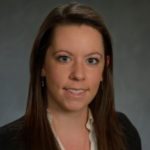Maura Kirk, MS
I would be lying if I said that I had always dreamed of becoming a medical physicist and working in radiation oncology. In fact, when I entered college as a physics major, I had no idea that this field even existed. I had been interested in medicine since I was young, but after taking Anatomy and Physics classes simultaneously in high school, I found that I much preferred problem solving over memorization. I started to doubt how much I would like medical school and began leaning toward physics for a career. I did not know exactly what I was going to do, but I knew that most people have a strong aversion to physics while I was attracted to the challenge, so I decided to go for it.
During my sophomore year as a physics major at Villanova University, a ‘Nova Physics alumnus came to give a talk to our department about his career as a medical physicist. I was instantly interested. He described how medical physicists work together with radiation oncologists and other medical professionals in the clinic, combining mathematical problem solving with patient treatment planning, quality assurance, and other clinical duties in radiation oncology.
Medical physics sounded like an ideal career for me, uniting my interests in physics and medicine, and I wanted to know how I could prepare myself to be a good candidate for a career in medical physics. I found that the American Association of Physicists in Medicine (AAPM) offered summer fellowships for undergraduates, allowing students to be introduced to life as a medical physicist. I applied and was offered a fellowship that summer, which I spent in Kansas City, Missouri shadowing the medical physicist that had come to Villanova and inspired my interest in the field.
Throughout the summer I had a wonderful experience and became confident that I would pursue medical physics as a career. I found that the daily challenges involved in the uniqueness of patient treatments meant being constantly on my toes, which was something I really enjoyed. At that point I was able to truly see myself enjoying medical physics as an occupation for life. After seeking advice from the medical physicists that I had met about becoming a successful candidate for graduate school in medical physics, I spent my final two years at Villanova diversifying my science course exposure beyond physics to computer science and biology. When applying for graduate school, I found that my exposure to computer programming was especially beneficial for research positions.
For graduate school I attended the University of Pennsylvania where I received a Masters of Medical Physics. I was lucky enough to attain a research fellowship while I was a student, during which my research was mainly focused on Monte Carlo simulations of proton beam characteristics at the Roberts Proton Therapy Center. It was an especially exciting time as the department was preparing to treat our first proton therapy patients. I was luckier still to be offered a job as a medical physicist at the University of Pennsylvania upon completion of graduate school. I can honestly say that I love my job, I am certainly never bored, and I feel as though I have an impact on patients” lives each day while I am at work. I will be forever grateful to the physicist who introduced me to the world of medical physics for helping me find the direction that lead me to this profession.
